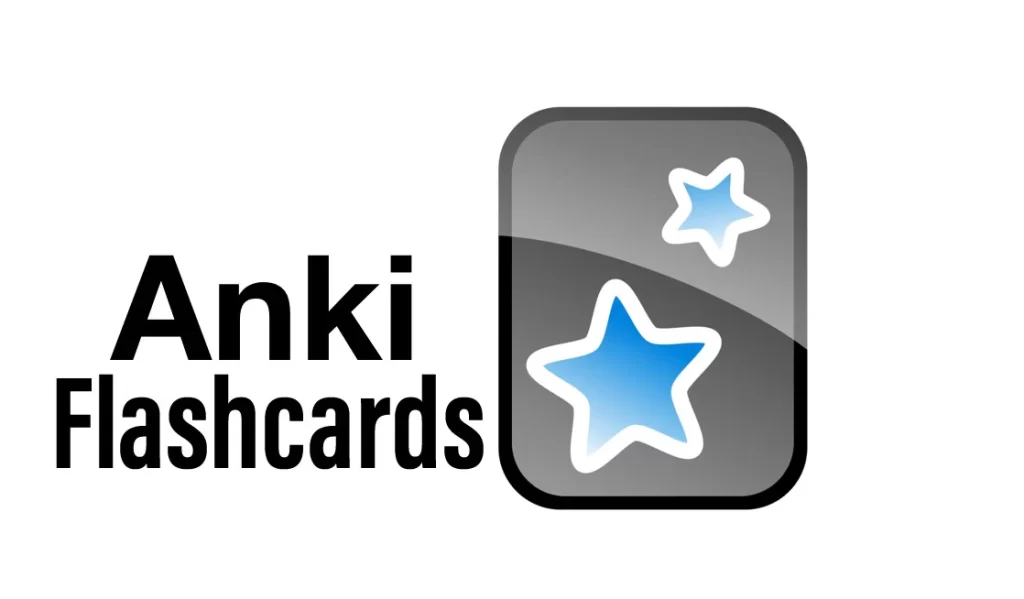How to Study With Anki
You will use Anki most heavily at the beginner level since this is where the most direct memorization takes place. You should use it as a tool to increase your comprehension and mostly focus on cards where you translate Chinese to English. Your goal is to build word recognition, so you can understand vocabulary when you come across them in other resources. As you progress, flashcards should take up less and less of your study time. If you find that your flashcards have piled up, don’t worry. You don’t need to do all of your reviews every single day. Anki is fully adjustable for a reason. For optimal retention, you should have only a few new cards each day and unlimited reviews. However, it all depends on what you find comfortable and can manage. If doing many reviews is boring, reduce it. If you can’t remember 10 words at once, reduce it. Play around with Anki a bit to see how you like to study. If you don’t want to spend the time making your own cards, I have a deck of over 10,000 of the most common Chinese words with audio and example sentences perfect for building up your vocabulary! It’s called the Chinese Practice Vocabulary deck, and you can find it linked below!
How to Set Up Anki
Anki on PC
Go to the Anki website and download the correct installer for your computer.

After you have downloaded and opened Anki, it will display this page. Yours won’t have any decks, but the options will be the same.

Anki decks will end in .apkg. They can easily be transferred and shared as independent files. To add downloaded decks to Anki, simply double-click on the deck you want to add. The decks linked below are the ones used in the Chinese Language Pathway. They will be explained in more depth later.

When you import a deck, it will ask you if you want to import learning progress or deck presets. Usually, you do not want to import learning progress as someone else’s progress won’t help you. However, you will likely want to import deck presets. This is how many new cards and reviews you will see each day as well as other settings specific to this deck. If you like using your own presets, then you can leave the option off. When you’re done, click “Import” at the top of the screen.
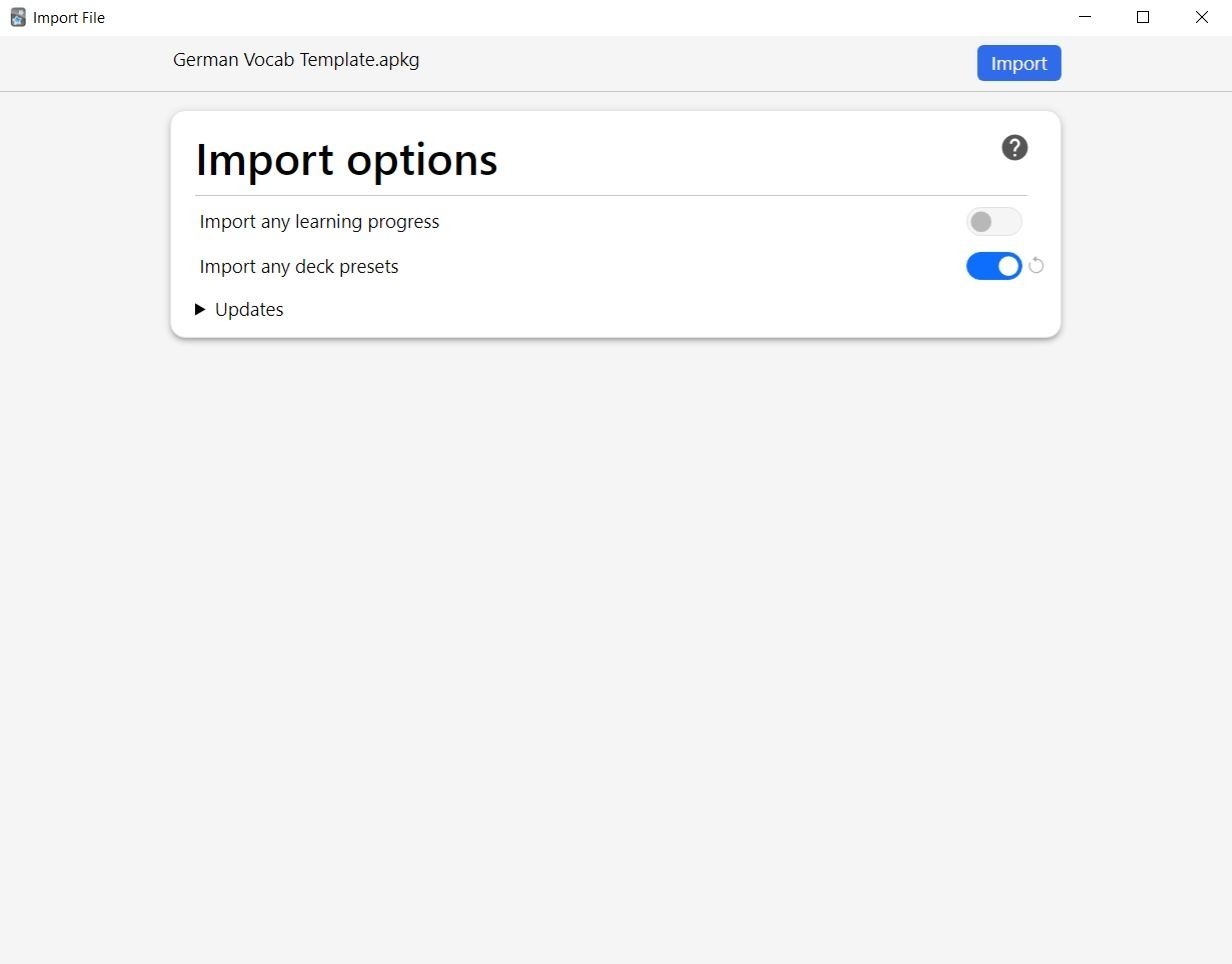
To add new individual cards to a deck, first click on the deck you want to add the new card to, then press “add” on the toolbar at the top of the screen. In the image below, the new card will go into the Chinese Sentences deck.

This is where you enter the information to make a new card. At the top of the screen, you can change the type (this changes the fields and how the card looks when finished) or the deck. The fields are pretty self-explanatory and should be filled out according to how they are labeled. Once you click add, the card will automatically be added to its respective deck. It’s easiest to add audio after the card has been created, and I’ll show you how to do that later in tips. When you are done adding cards, click “close” in the bottom right corner.

To see all the cards in your deck, click on “browse” from the main screen.

Here in browse you can sort through and edit your cards. To search for a specific keyword, type it in the top search bar. You can also sort cards by deck, tag, or state in the left column. To edit a card, simply click on it. The browse menu can be a little tricky to navigate at first, so I recommend just looking around to see where everything is. As you look through it more, it will become more familiar.

Back in the main menu, click on a deck to open it.

You’ll be presented with a few options when you open a deck. The one you’ll use the most is “study now.” However, we’re first going to look at “options” on the bottom left of the screen.

The options menu is where you select how many new cards you see each day and how many reviews you have each day. What you set this to will depend on how you like to learn. For optimal retention, you should have a low number of new cards a day and unlimited reviews.
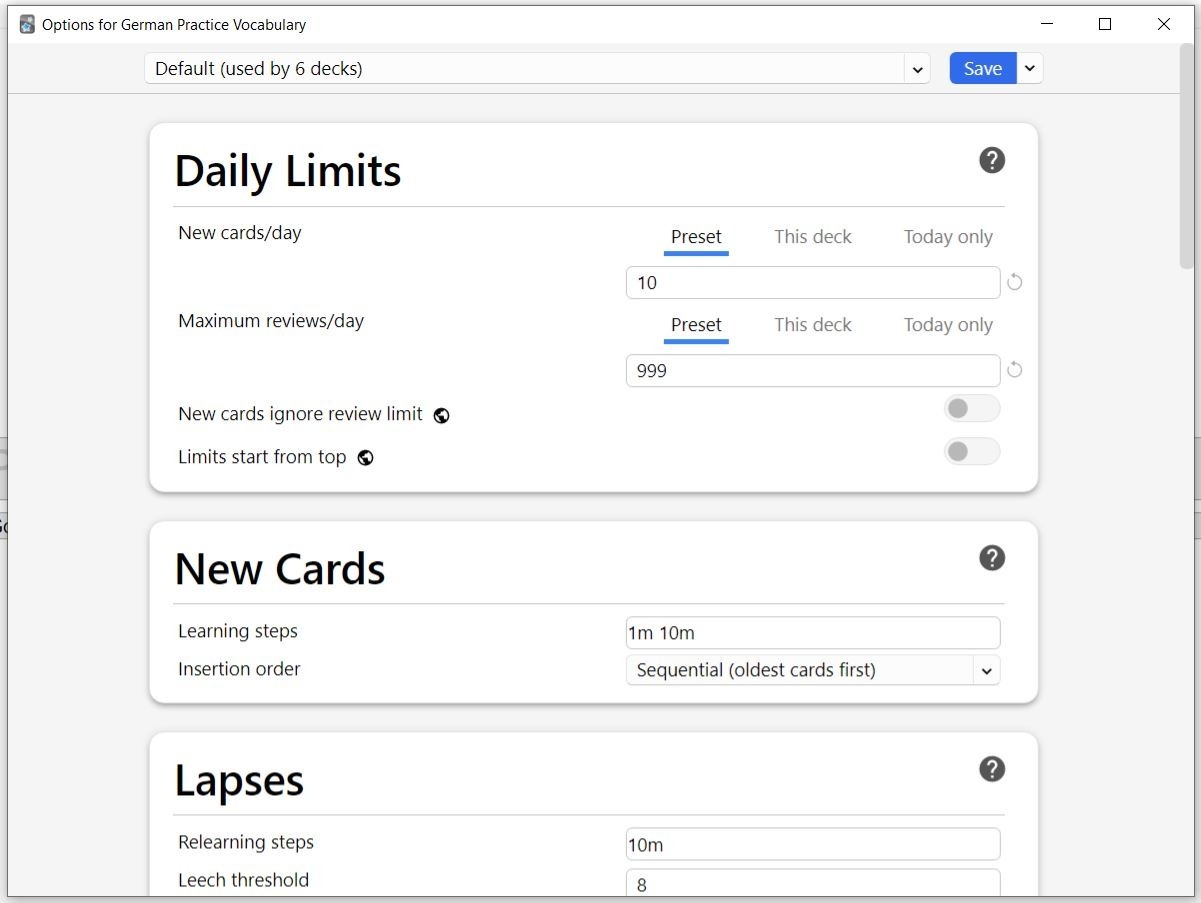
If you miss a few days and have a lot of reviews, don’t panic. Just set your new cards per day to zero and slowly work your way through your reviews as you have time. Don’t overdo it or you’ll get burnt out. Anki is just a memorization tool. You don’t need to stick to it exactly, just do cards as you have time.
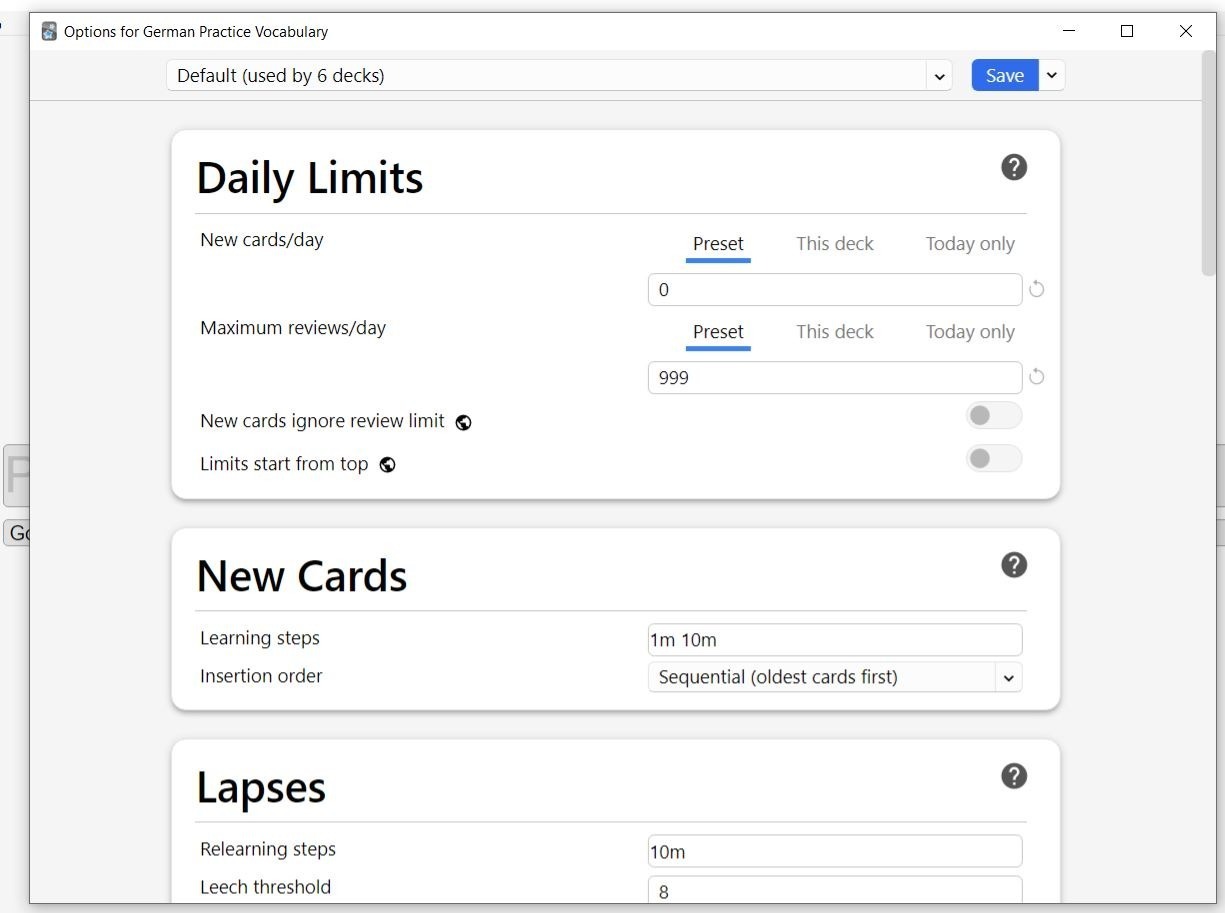
The way I personally use Anki is not the most optimal for memorization. I don’t like doing all my reviews every day and prefer to be exposed to more new material, so I set my reviews lower than recommended. I also turn on “new cards ignore review limit,” so I see new cards every day. I’m not trying to remember every single word and sentence perfectly, I just want to review them a few times, so I can recognize these vocabulary words when I come across them later. I find that as long as I’m regularly getting exposure from native sources in combination with Anki, I am able to build a strong foundational vocabulary without spending long amounts of time reviewing flashcards. Typically, I am to spend about 20-30 minutes on Anki a day when I first start a language, then I decrease that over time to as low as 10 minutes a day.
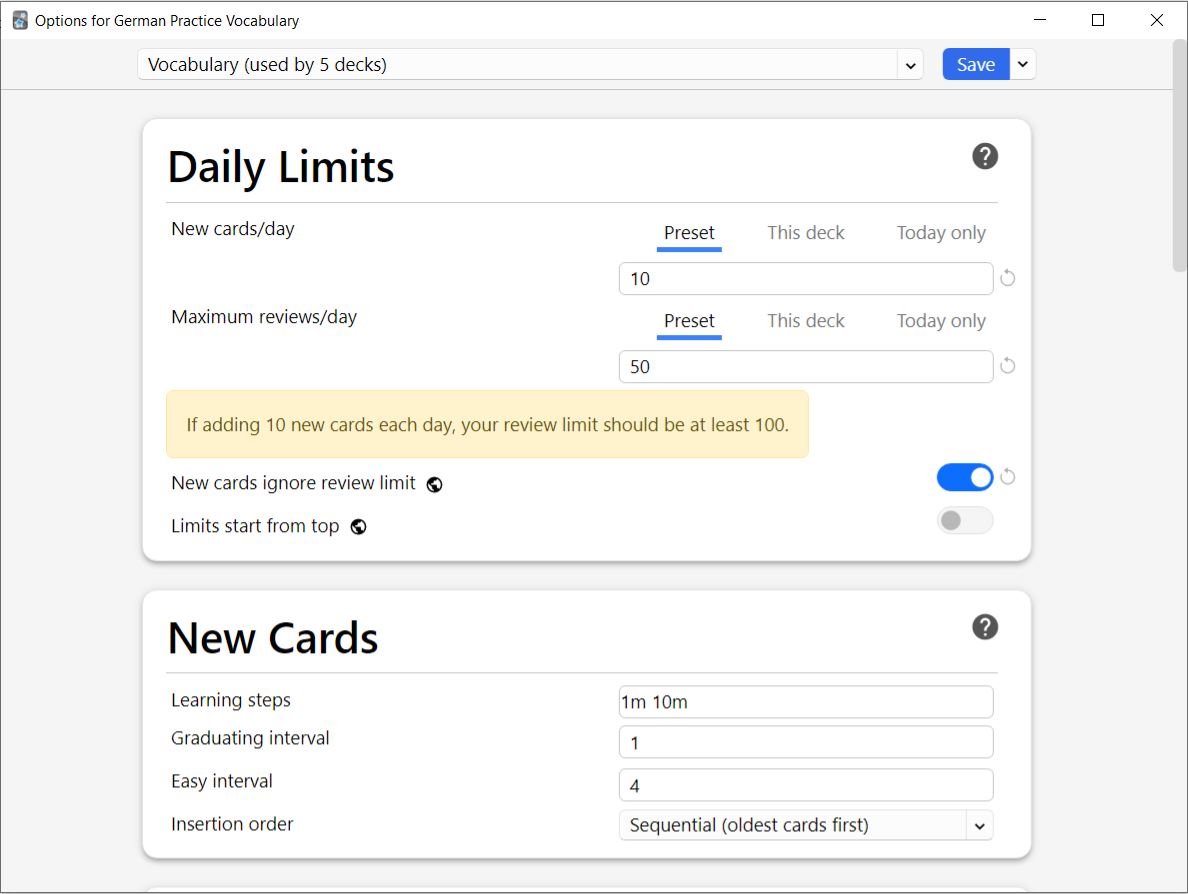
If you scroll down a little farther in the options, you will see the option to enable FSRS. FSRS is a new algorithm that tracks how you learn and optimizes when you see review cards. If you have a newer version of Anki installed, I highly recommend turning this setting on. When you first turn on FSRS, it will present you with the default study intervals, but the longer you study with Anki and the more reviews you do, the more it will adapt to you. The default study retention is 0.9, which means the algorithm will space out your reviews so you remember about 90% of the cards. You can change this to whatever you like, but it’s not recommended to go below 0.85.
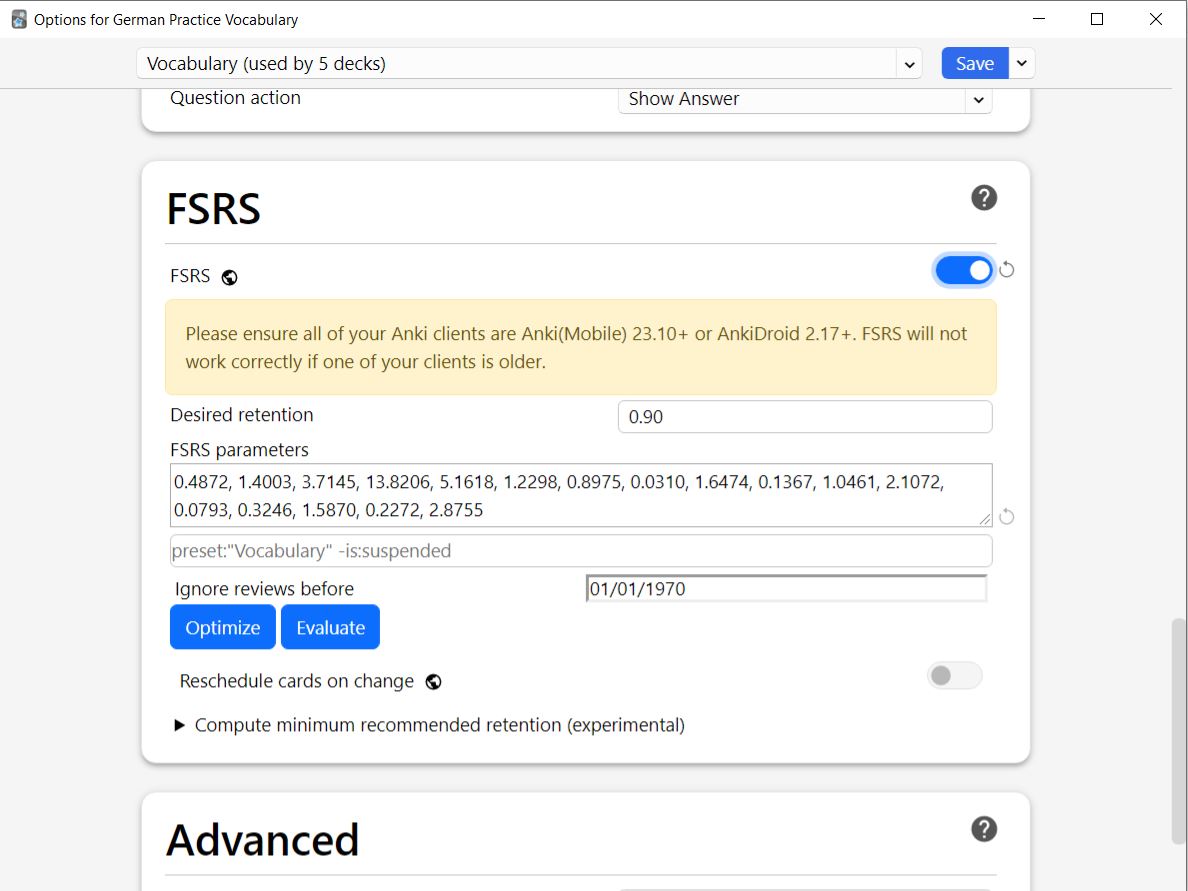
After you have selected how many cards you want to study every day, go back and select “study now.” Your flashcards will now appear in study mode. In the center of the screen, you’ll see the flashcard prompt. In this case, it is a Chinese sentence, so your goal is to read and understand the sentence. At the bottom of the screen in the left corner, you’ll see “edit.” This allows you to change the individual card you are currently looking at. In the center at the bottom of the screen, you’ll see three numbers. The blue number is the number of new cards you have today, the red number is the number of cards you are currently studying, and the green number is the number of reviews. When you are ready to see the answer, press “show answer.”

Once the card is flipped over, you will grade yourself. How you grade yourself will dictate when you see this card next. In this case, if you couldn’t read the card at all, you would press “again.” If you could understand it a little but not fully, you would press “hard.” If you could understand and read it, but it took some time, you would press “good.” If you can easily read and understand it, press “easy.” You will learn how to grade yourself over time. If stuck between two levels, choose the lower one. For example, if you’re not sure if you should choose “hard” or “good,” choose “hard.”

If you would like to get more out of your Anki sessions, you can use Anki’s built-in recording feature to record your voice and compare it to the flashcard audio. When I study, I will read the word and sentence out loud before flipping over the card, then compare my pronunciation and tones to the card audio. To use this feature on a computer press “Shift+v” to record and “v” to listen back to the recording. You can also find this option in the “more” menu in the bottom right corner.

Another way to get more out of your flashcards is to use the sentences as prompts for your own sentence creation. For example, I can take the sentence on the card below and switch out different words in the sentence to change the meaning. I can change the adjective describing the cups to green. “她买了八个绿色的杯子.” “She bought eight green cups.” I can change how many cups she bought to four. “她买了四个大杯子.” “She bought four big cups.” I can also change what she did with cups to selling. “她卖了八个大杯子.” “She sold eight big cups.” Creating your own sentences will reinforce the words and patterns you’ve learned, as well as improve your recall time and speaking ability. If you would like to challenge yourself, try to come up with a new sentence for each flashcard you review. If you’re not sure if a sentence you created is correct, you can always ask ChatGPT or use a website like HiNative.

When you are done studying for the day, press the sync button in the upper right corner of the main screen. This will upload your progress to AnkiWeb so you can save your progress and study on other devices. Sync will also automatically be activated every time you open or close Anki.
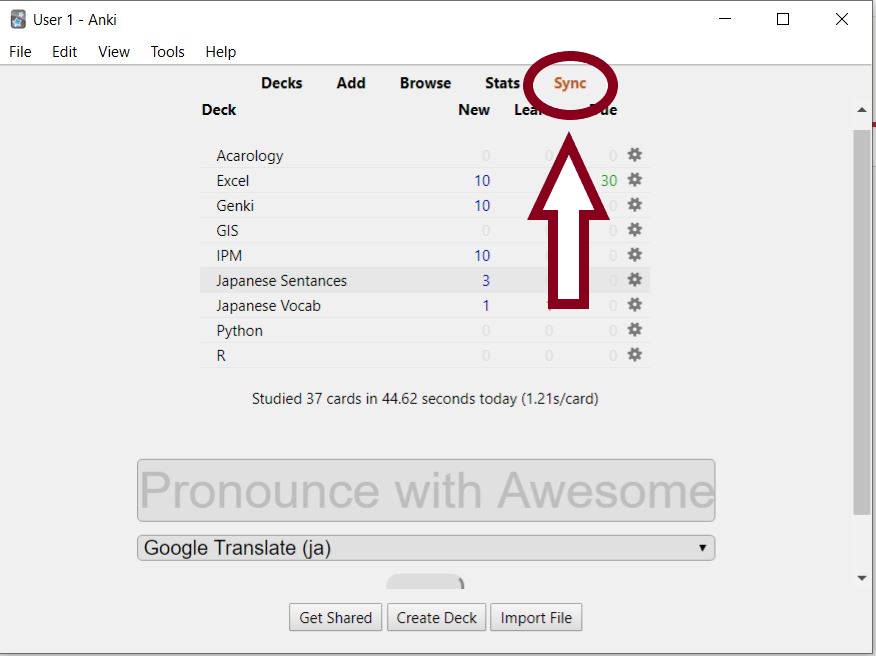
Anki on Mobile
On Android Anki is free, but on IOS, the Anki app is about $25. If this is too expensive for you, you can use AnkiWeb, which is the free browser-based version of Anki. AnkiWeb is mostly used for studying cards, so you will need to use a computer to create and edit large decks or use add-ons.
Once you download the Anki app, you will open it to see this page, but you won’t have any decks yet.
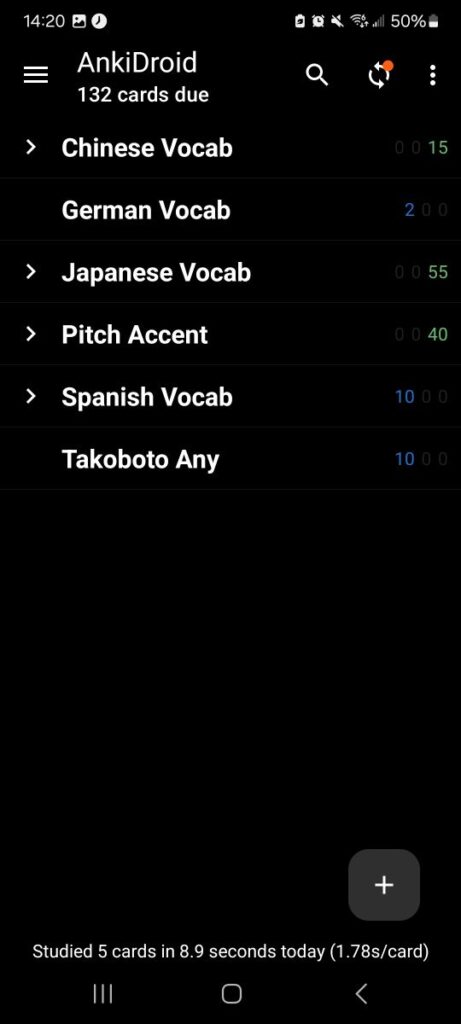
If you already have an Anki account with Anki decks, press the sync button to sign-in and see your existing decks.
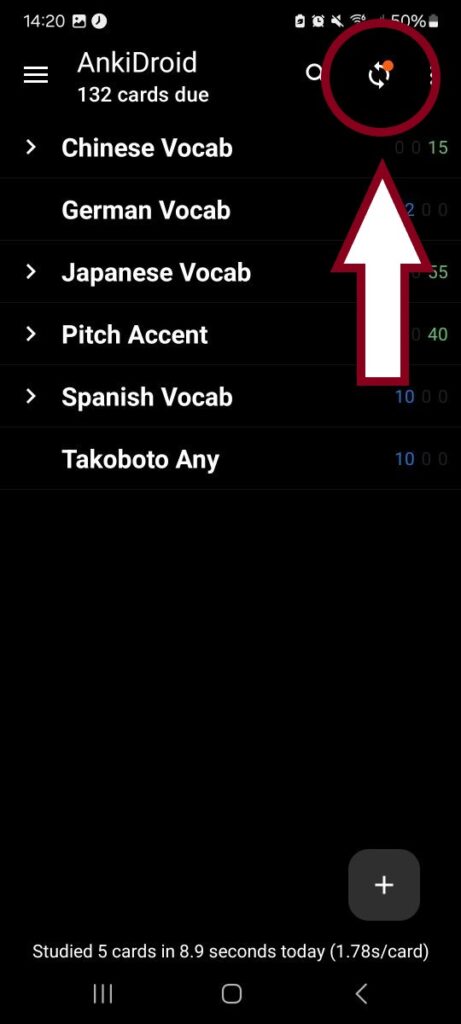
If you need to add an Anki deck, press the three dots in the upper right corner.
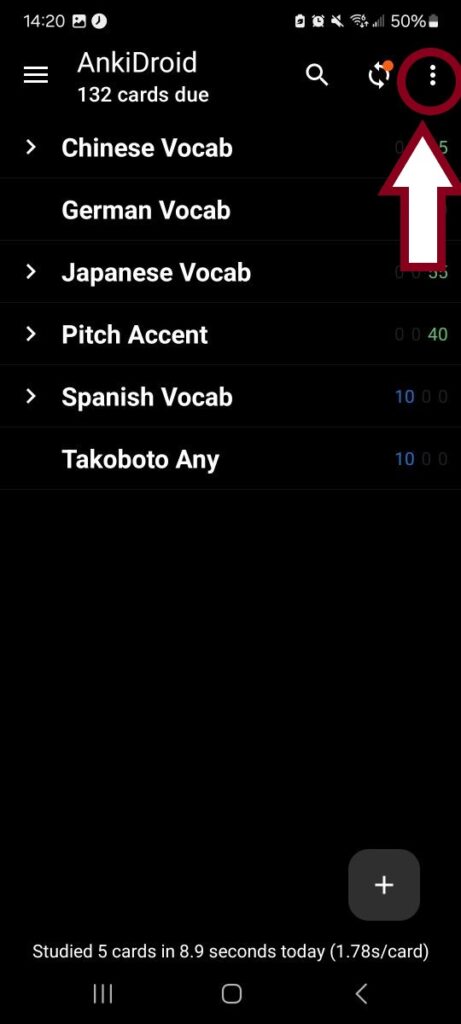
Next, click import to select the Anki deck you want to study from your phone’s documents.
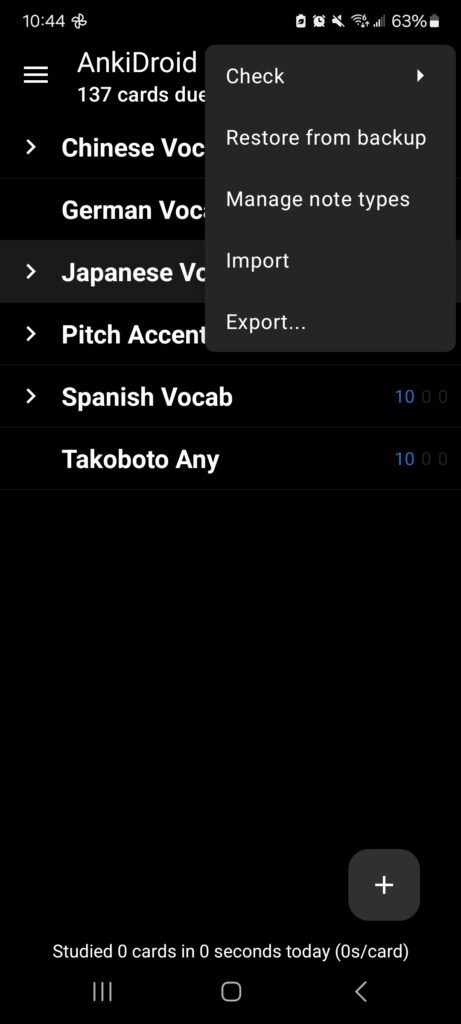
The decks below are part of the Chinese Language Pathway and will be explained in more depth later. You can use one of them to practice importing a deck.
If you press the plus sign in the bottom right corner, you will see a menu where you can create new cards and decks. From this menu, you can also add community decks by selecting “get shared decks.”
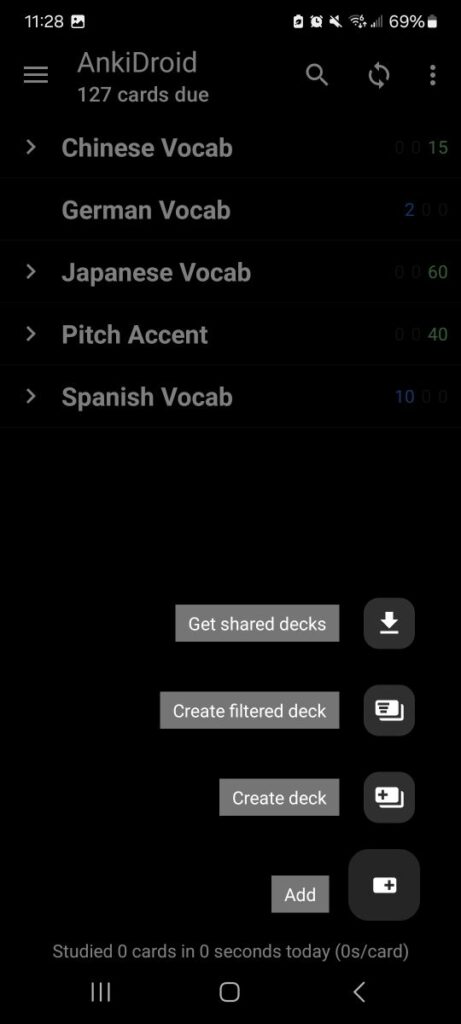
When you press “add,” the add new card screen will pop up. You can change the card type and deck at the top of the screen. Fill out the sections of the card accordingly, and when you’re done, press the checkmark in the upper right corner. Audio can not be added on mobile and must be added on a computer. See tips for more information.
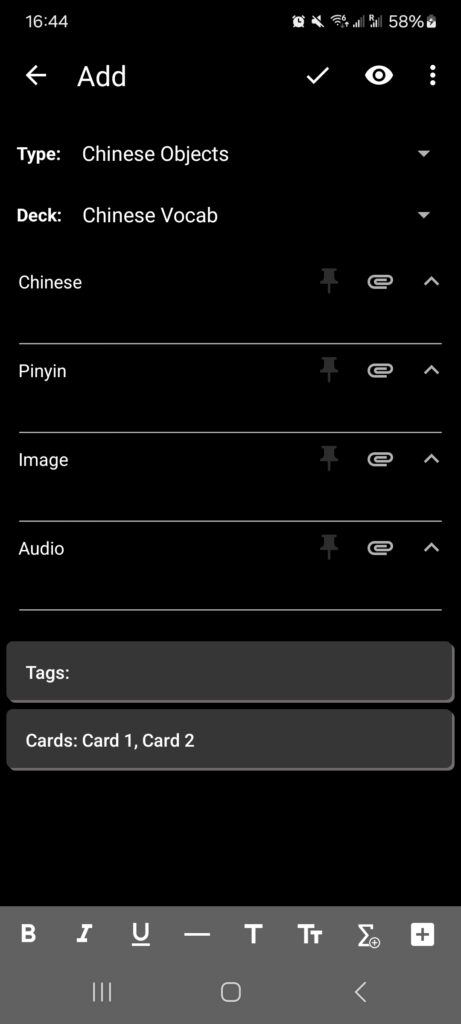
To alter a deck, go back to the main screen, and long press on the deck you want to change. From here you can add new cards, browse current cards, or rename the deck, but first go to “deck options.”
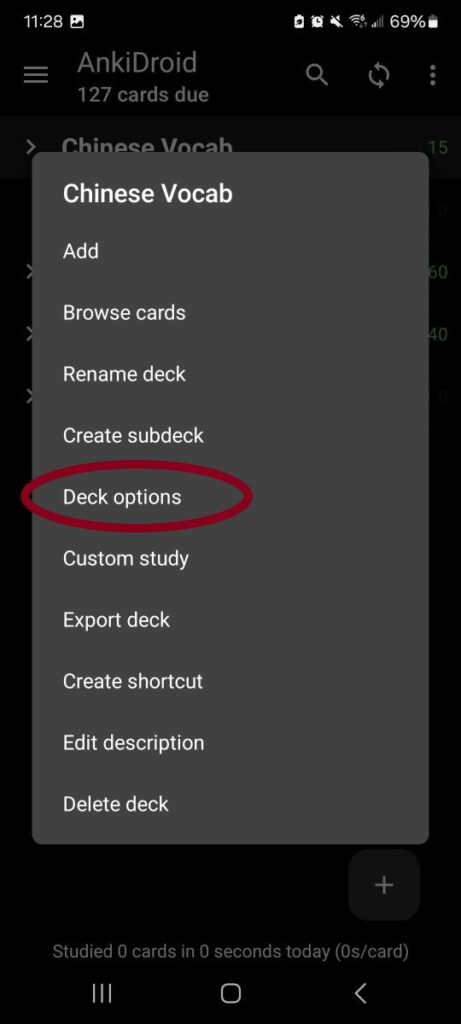
The options menu is where you select how many new cards you see each day and how many reviews you have each day. What you set this to will depend on how you like to learn. For optimal retention, you should have a low number of new cards a day and unlimited reviews.
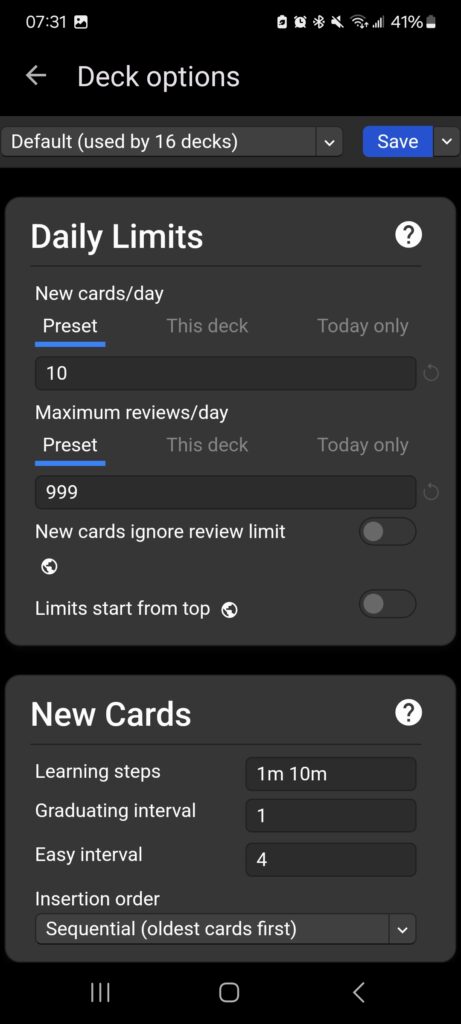
If you miss a few days and have a lot of reviews, don’t panic. Just set your new cards per day to zero and slowly work your way through your reviews as you have time. Don’t overdo it or you’ll get burnt out. Anki is just a memorization tool. You don’t need to stick to it exactly, just do cards as you have time.
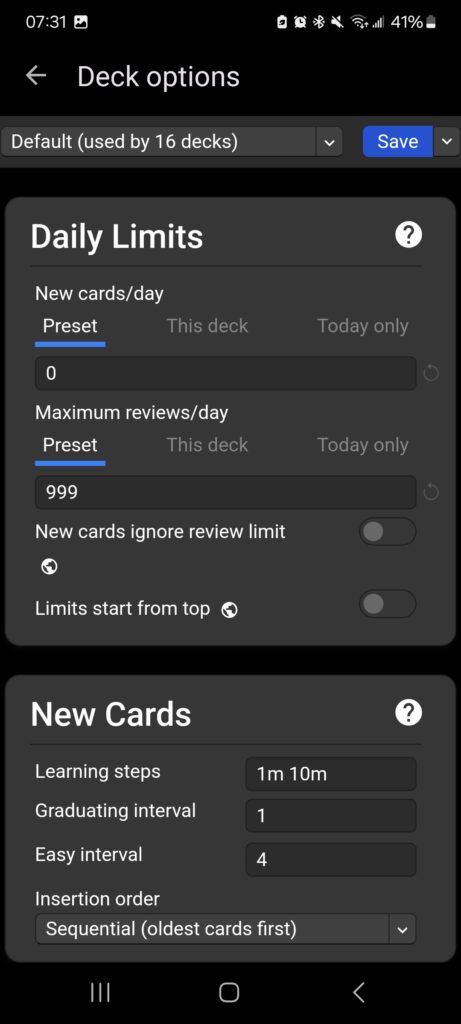
The way I personally use Anki is not the most optimal for memorization. I don’t like doing all my reviews every day and prefer to be exposed to more new material, so I set my reviews lower than recommended. I also turn on “new cards ignore review limit,” so I see new cards every day. I’m not trying to remember every single word and sentence perfectly, I just want to review them a few times, so I can recognize these vocabulary words when I come across them later. I find that as long as I’m regularly getting exposure from native sources in combination with Anki, I am able to build a strong foundational vocabulary without spending long amounts of time reviewing flashcards. Typically, I am to spend about 20-30 minutes on Anki a day when I first start a language, then I decrease that over time to as low as 10 minutes a day.
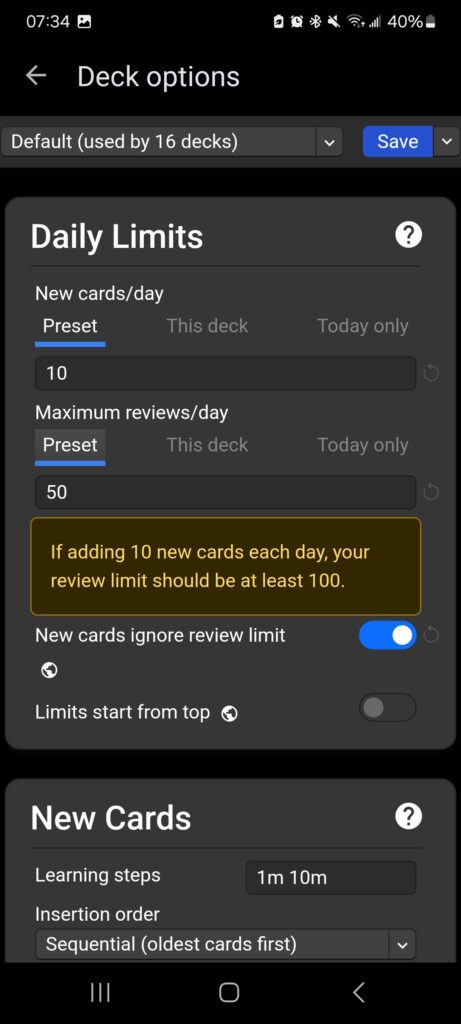
If you scroll down a little farther in the options, you will see the option to enable FSRS. FSRS is a new algorithm that tracks how you learn and optimizes when you see review cards. If you have a newer version of Anki installed, I highly recommend turning this setting on. When you first turn on FSRS, it will present you with the default study intervals, but the longer you study with Anki and the more reviews you do, the more it will adapt to you. The default study retention is 0.9, which means the algorithm will space out your reviews so you remember about 90% of the cards. You can change this to whatever you like, but it’s not recommended to go below 0.85.
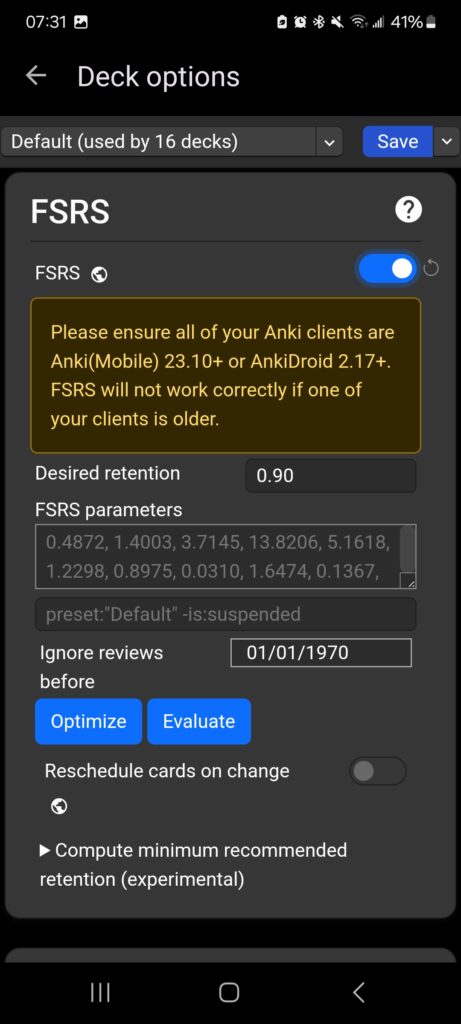
To start studying your flashcards, single click on a deck on the main screen. Below is what a flashcard looks like. This is a type card, so there is an area at the bottom of the screen for entering your answer. Normally, you will answer in your head or out loud then press the show answer button. To edit a card, click the three dots in the upper right corner. The numbers in the upper left corner show how many new cards, current cards, and review cards you still have for the day.
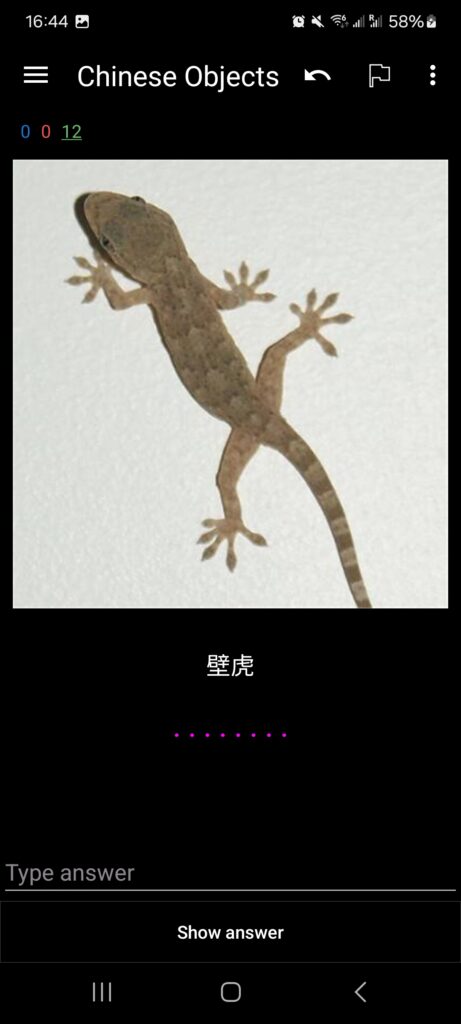
After you press “show answer,” you will see the back of the card and grade yourself based on how well you know the material on the card. How you grade yourself affects when you’ll see the card again. If you are stuck between grades, go with the lower one. For example, if you are between “good” and “easy,” select “good.” It never hurts to review more.
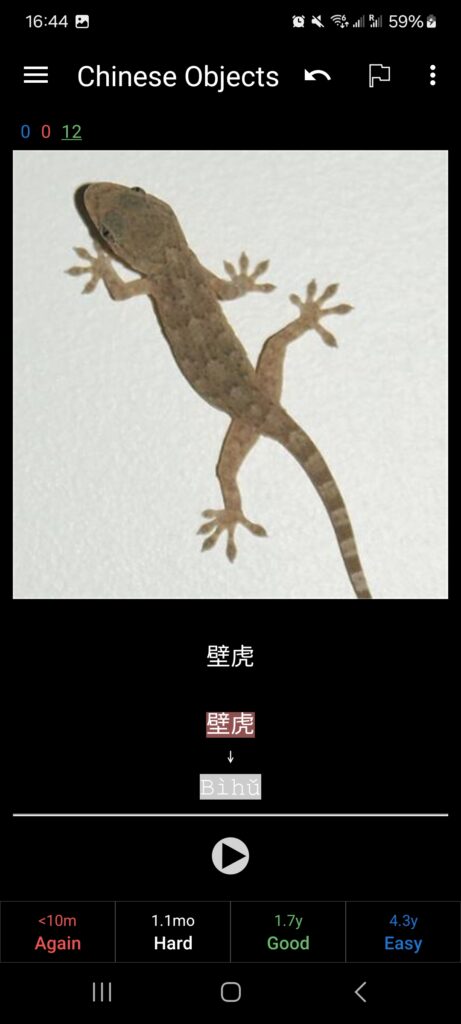
If you would like to get more out of your Anki sessions, you can use Anki’s built-in recording feature to record your voice and compare it to the flashcard audio. When I study, I will read the word and sentence out loud before flipping over the card, then compare my pronunciation and tones to the card audio. To use this feature on a phone, click on the three dots in the upper right corner, then select “Enable voice playback.”
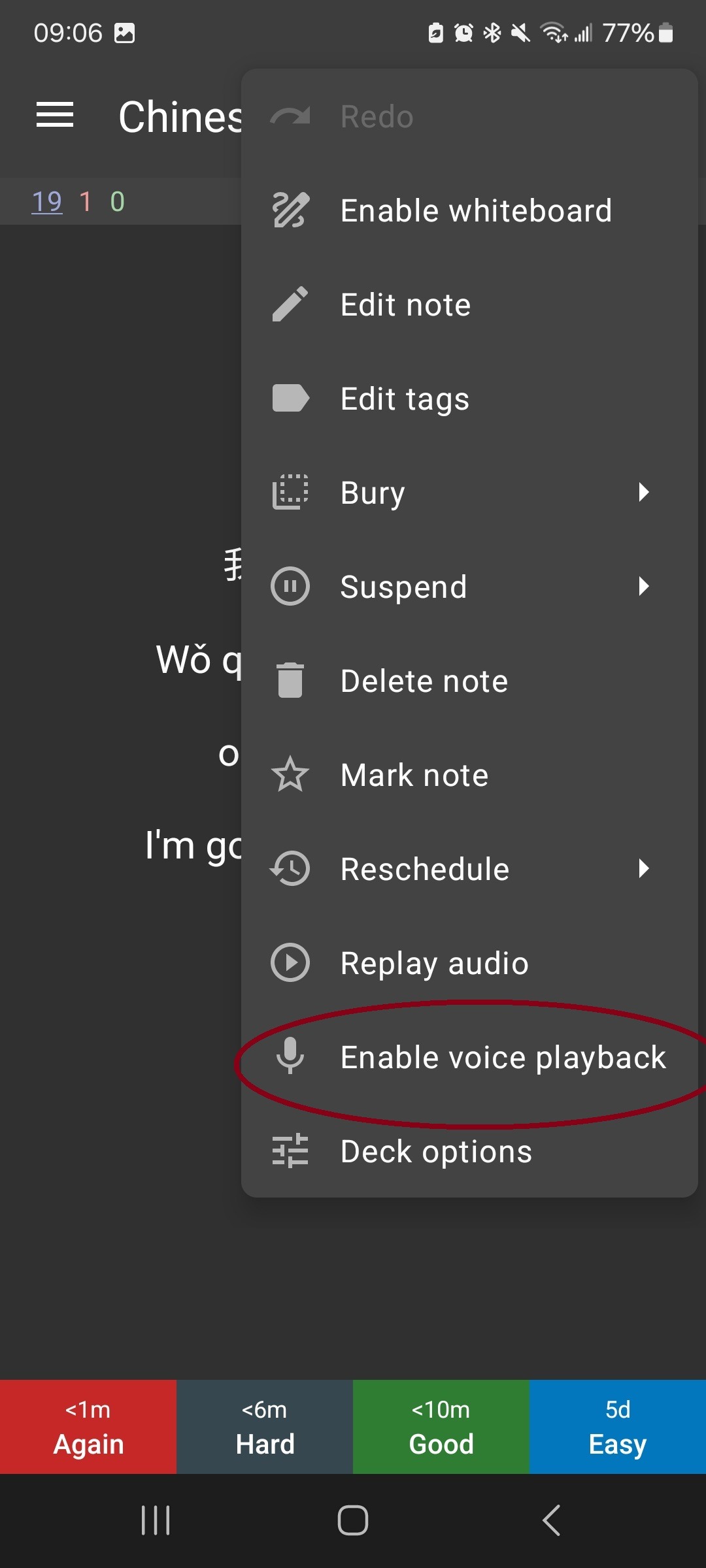
Another way to get more out of your flashcards is to use the sentences as prompts for your own sentence creation. For example, I can take the sentence on the card below and switch out different words in the sentence to change the meaning. I can change what I am going to do outside. “我去外面运动.” “I’m going to exercise outside.” I can also change where I’m going to eat. “我去里面吃饭.” “I’m going to eat inside.” Creating your own sentences will reinforce the words and patterns you’ve learned, as well as improve your recall time and speaking ability. If you would like to challenge yourself, try to come up with a new sentence for each flashcard you review. If you’re not sure if a sentence you created is correct, you can always ask ChatGPT or use a website like HiNative.
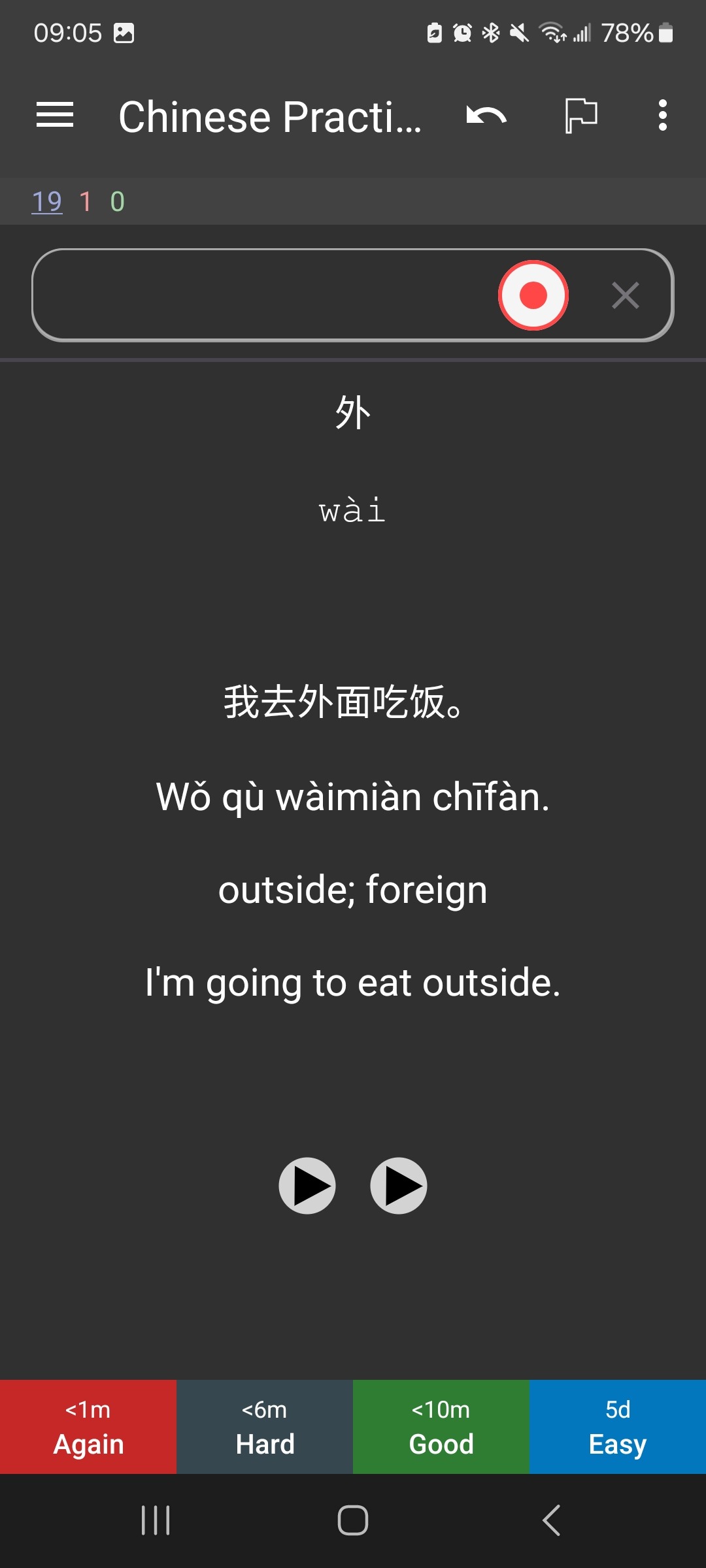
Deck of 10,000 Chinese Vocabulary words
If you don’t want to go through the hassle of making your own cards, you can use my premade deck called “Chinese Practice Vocabulary,” which has 10,000 Chinese vocabulary words with example sentences and audio. You can download it either directly from the Google Drive file or as an Anki shared deck, but you do not need to download both! The deck contains two types of cards to help you first build recognition of a word and then recall the word. Below is an example of a recognition card. It will show you a Chinese word and an example sentence, then ask you to type the character and remember the English translation. Typing the character is a good way to ensure you remember the pinyin and feel comfortable writing it. To help with your memorization, you may also try writing the character down on a piece of paper. I will also record myself reading the vocabulary word and sentence to the best of my ability using Anki’s built-in recording feature before flipping the card over, then I compare my recording to the audio on the card.

On the back side of the card, you will grade yourself based on how easily you can read and understand the word. Typing is optional, so you can say the word out loud or in your head instead. Just make sure you are grading yourself accurately, or the spaced repetition algorithm won’t be able to show you words at the right time. Grade yourself on how well you were able to recall the word’s pronunciation, tone, and meaning. Remember, if you don’t know the tone, you don’t know the word! Just knowing the sounds isn’t enough!

The second type of card will ask you to recall the vocabulary word. It will give you the example sentence with the word removed and the English translation. You should then type the hazi for the word in the provided space. Alternatively, you may also write the word down on a piece of paper or record yourself saying it using Anki’s built-in recording feature. If you’re struggling to read the Chinese sentence, you can click on the blue text that says “English Sentence” for the English translation. However, I would only use this if you need it.

On the back, Anki will show you if there are any omitted or extra characters in your answer, but you will still need to grade yourself. Although typing the words is optional, I still highly recommend it because it will improve your recall and thoroughly test your abilities. If you decided to write the vocabulary word, you can compare your stroke order to the animation at the bottom of the card, and if you decided to record yourself reading the word and sentence, then you can compare your pronunciation to the card’s audio.

Although this deck doesn’t come with images, it does have a field where you can add your own images. Adding an image is great for words you struggle to remember as it will create a visual association with the word. To add an image, click “edit” in the screen’s bottom left corner, then copy and paste the image of your choice into the image field. When you’re done, click “close” in the bottom right corner.

Now when you see this card again, it will have the image you added on it!
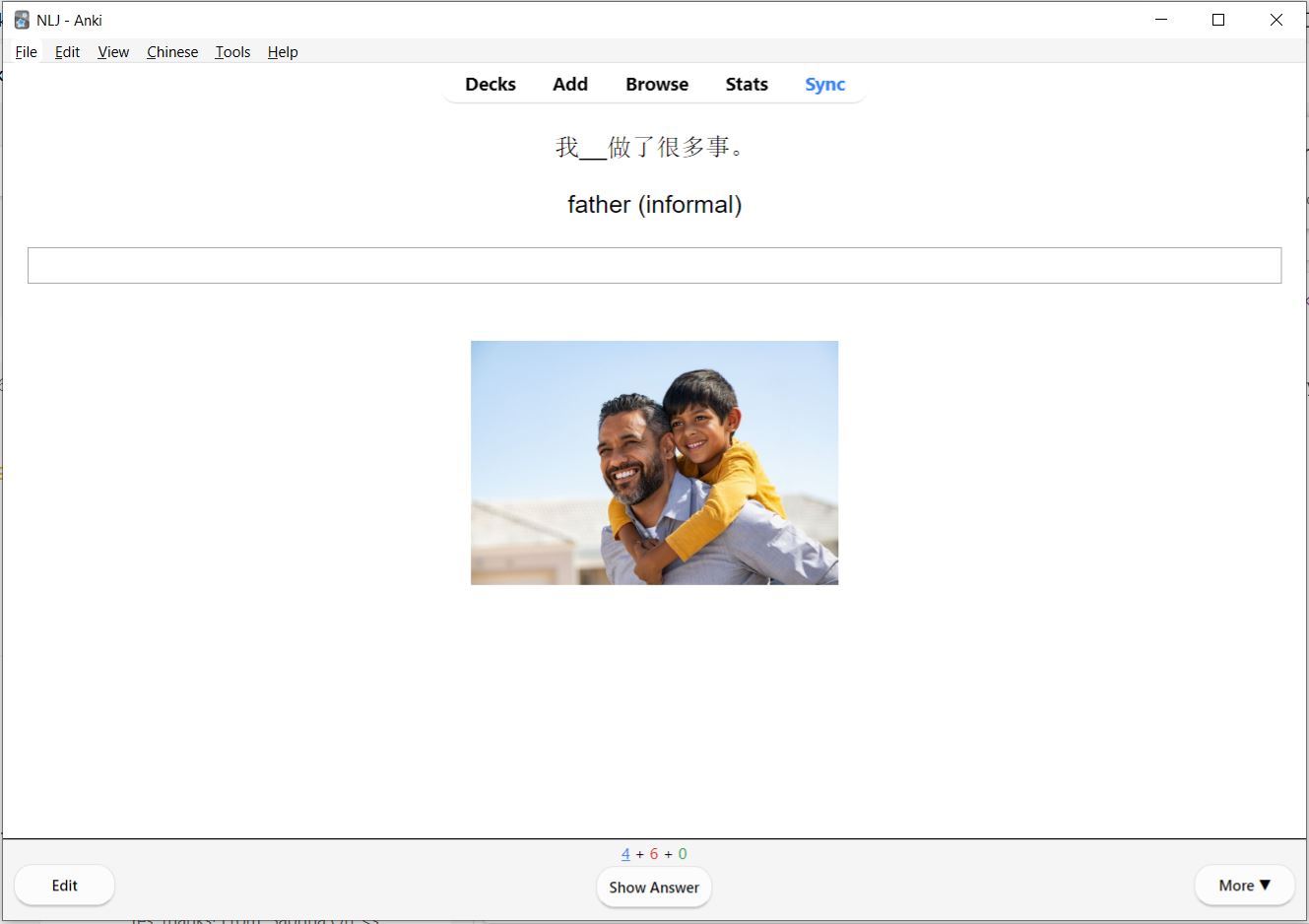
Tips for Creating Chinese Flashcards
Automatically Generated Cards
Because Anki is a free, open-source program, there are many useful add-ons available. One amazing add-on for Chinese learners is Chinese Support 3, which allows you to automatically generate flashcards for a Chinese word or sentence. To get this add-on, go to the add-on’s page and copy the download code.

Then in Anki, go up to the top of the page and click “tools” then click “add-ons.” You can also get there by pressing Ctrl + Shift + A.

Now enter the code you got from the Chinese Support 3 webpage and press ok.

Now download the Chinese support template deck and import it into Anki.

Open the template deck in Anki and click on “Add.”

Make sure the type of card is “Chinese (Advanced)” or the add-on won’t work correctly. The card type is located in the upper left corner. Then make sure the 汉字 (hanzi) button is on. It will turn blue when it is activated.

Now type your vocabulary word into the hanzi field and press “tab” on your keyboard to automatically fill the other fields. For sentences, it will not automatically translate them to English, so you may need to fill in the English field manually. Also, it will give you all of the example sentences it has for the examples field. For common words, this may be quite a few sentences, so I usually choose one I like and delete the rest. If you don’t like dealing with example sentences, there is also an Anki deck template for cards with no examples. Click “add” when you’re done filling out the card.

When you study these cards, you will first be shown recognition cards where the character or sentence is presented to you, and your goal is to recall the pronunciation and meaning.

On the back side of the card, you will see the pinyin, meaning, and an example. You will grade yourself based on how well you were able to remember the meaning and pronunciation.

The second set of cards you will see are recall cards, which ask you to recall the Chinese character or sentence and type it out. This combination of recognition and recall cards will help you internalize vocabulary and build a strong foundation.

Custom Cards
Custom cards are cards where you manually fill out all of the fields. They are more time-consuming to make, but they are specifically tailored to you, and you can use vocabulary and example sentences you have found through reading or listening. There are two types of cards you will want to focus on making: vocabulary cards and sentence cards. You can find the templates for these below.
When making vocabulary cards, focus on making just 5 new cards a day from material you have read or watched. Making too many cards is a mistake I often see with new learners, and it causes them to burn out and drop Anki altogether. Quality over quantity! You don’t need to make a card for every single new word or sentence. Just pick the ones that are most relevant or important to you. If a word is common, you will see it again later! It doesn’t help to make a bunch of cards you never study.
When creating vocabulary cards, fill out the fields according to how they are labeled. In the first field, put the commonly written form of a word. I know it may seem intimidating to make flashcards with hanzi on them but trust me, you’ll be glad you did. As you learn new words, you should learn the hanzi with them. The best way to learn to read hanzi is through exposure, and this will save you a lot of headaches down the line. The Chinese and English fields should always be filled in. The image and example fields are optional. I generally only add images for nouns. You can easily add an image by dragging it into the image field from Google or a folder on your computer. Press “add” in the bottom right corner when you’ve finished filling out the fields. Audio and pinyin will be added later.

After you add a new card, it will generate two different types of cards. The first card will be a type card. This card asks you to type the character you see. You can type either the pinyin or hanzi for the word. After you flip the card, you will grade yourself on your ability to read and understand the word presented. This is one of the best techniques for learning how to read hanzi while also picking up new vocabulary.

For the second type of vocabulary card, you will be presented with the English translation and need to remember the Chinese word. Grade yourself based on how easily you can remember the Chinese word.

Sentence cards focus on reading and comprehension. Only the Chinese and English fields need to be filled out. It’s up to you if you fill out the pinyin field. If you just started learning Chinese, I recommend putting the full sentence in pinyin, but as you get better and can read more hanzi, I recommend only putting pinyin for words you can’t read. Press “add” when you’ve finished filling out the fields. I’ll show you how to add audio later.

The first type of sentence card shows a sentence on the front for you to read. On the back will be the pinyin reading and the English translation. You will grade yourself on how well you can read and understand the sentence.

The second type of sentence card focuses on listening comprehension. A sentence will be read out loud to you, and you will grade yourself based on how well you understood it. These cards are optional, and you can download the template without audio cards if you’d like.

Add Audio to Your Flashcards
To add audio to your cards, you need to go to the webpage for the AwesomeTTS Anki extension. Scroll down until you find the add-on code and copy it.
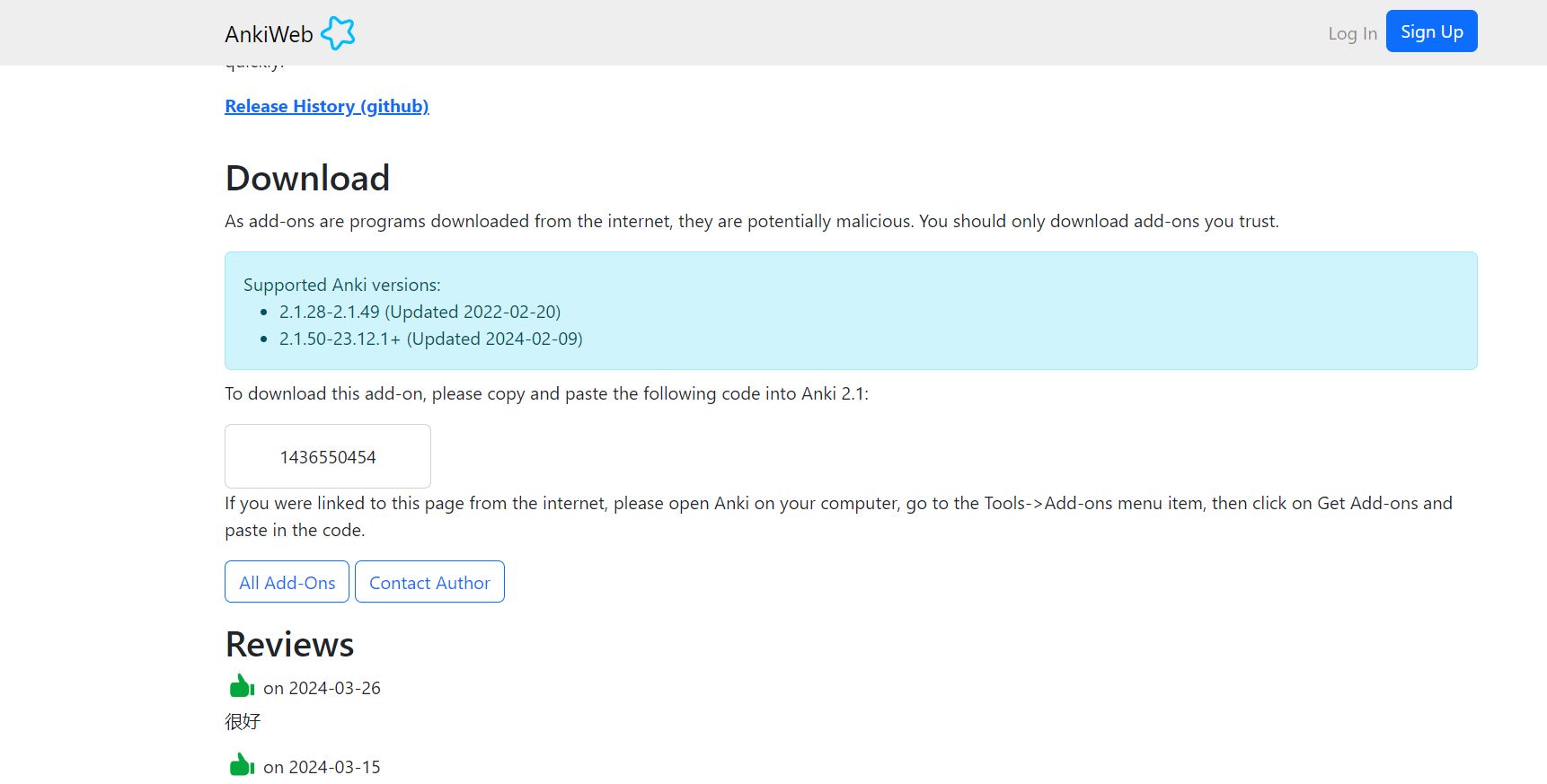
In Anki, go up to the top of the page and click “tools” then click “add-ons.” You can also get there by pressing Ctrl + Shift + A.

Now enter the code you got from the AwesomeTTS webpage and press ok.
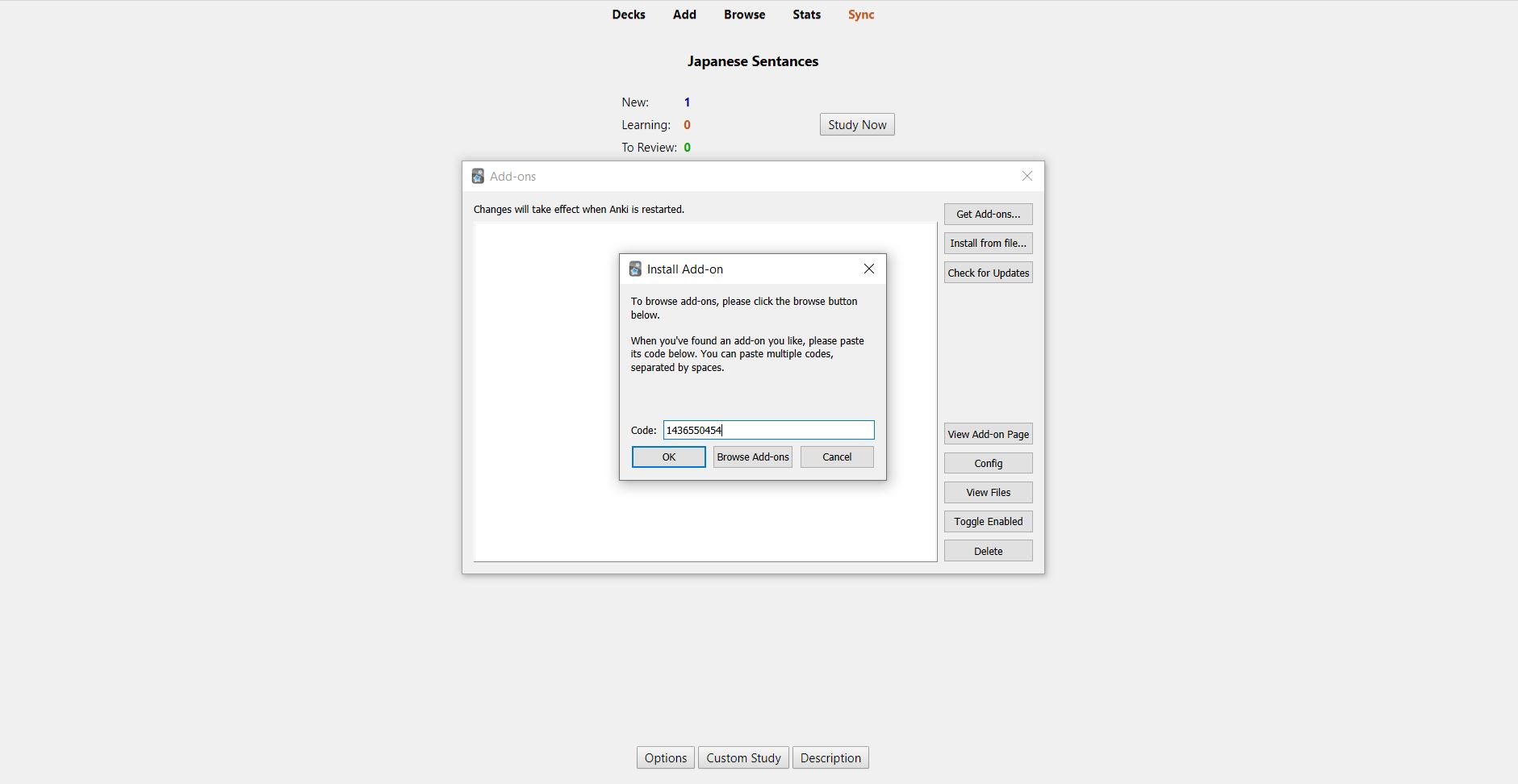
Once the add-on is installed, go to “browse” and you should see AwesomeTTS was added to your top toolbar. You may need to restart Anki if it hasn’t appeared. Next, select all the cards you want to add audio to and click “AwesomeTTS.”

This is where you can choose what voice you want to put on your cards. The easiest voice to use is Google Translate, so select that first. Then make sure you have the voice set to Chinese (Simplified). Select “Chinese” for your source field and “audio” for your destination field, then press “generate.” If you’re not sure you set everything correctly, compare your screen to the image below. Click “Generate” and the program will automatically add audio to all of your selected cards.

If you are only adding a few cards to your deck or updating a single card, you may choose to add audio in the card creation screen. To do this, select the Chinese sentence you want to generate audio for and copy it to your clipboard using Ctrl + C.

Next, place your mouse cursor in the field you want the audio file to go into, then click on the speaker button in your toolbar.

AwsomeTTS will automatically paste the sentence from your clipboard into the textbox, but you may still edit it or type something else if you wish. Ensure you have the right language and settings selected, then click on “record.”

You will now see a sound tag in the field you selected. If you want to get rid of a sound tag, you can delete it as you would any other text.

If you would like higher-quality voices or larger batch generation, I recommend using Microsoft Azure. However, you will need to get an API key, which is a little complicated because it requires making an Azure account and giving them your payment information, even though it’s free. If you would like more information, you can click below.
Mnumonics
Mnemonics can be a great tool for memorization, and this is a trick I learned from the YouTube channel Language Jones. Mnemonics are phrases or images that help you memorize something, for example, using ROY G BIV to help you memorize the colors in a rainbow. This can work incredibly for memorizing new words or characters. For example, if I’m struggling to remember the character 洋, which means ocean, I might find it easier to memorize if I break it down into its components, which means sheep and water. Then I can ask ChatGPT for an image of a sheep on the ocean, and add it to my Anki flashcard for 洋 to help me remember it! You can often find some good mnemonics online, but I also recommend tailoring them to your own personal experiences, as that will help you remember things better. Also, remember, what may help one person remember something may not work for someone else, so try coming up with your own mnemonics to add to words you struggle with.

I hope you found this guide helpful and are ready to use Anki to its full potential. These are just add-ons and decks I have found the most useful in my studies. There are many other useful add-ons and decks to aid you on your language journey, and because Anki is open-source, it’s constantly being improved. Anki is an incredibly useful tool you can use to learn almost anything, and you now have the foundation to do just that!

